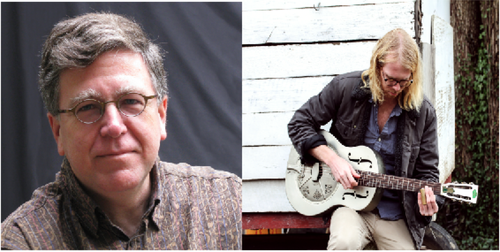
The following is a conversation between the author Peter Turchi and his son, musician Reed Turchi.
A Conversation Between Peter and Reed Turchi
Born and raised in the land of Old Bay and the Orioles, Peter Turchi was once a promising right-handed pitcher for Liberty Road Little League. Luckily, he turned to writing instead, in high school producing a play so groundbreaking that even the much-feared football coach played a part. From there he headed to Washington College, where he convinced unwary staff at the school press to let him print a poem about summers at the beach on sandpaper, before heading across the country to earn his MFA at the University of Arizona. Years later, he became director of the Warren Wilson College MFA Program, a position he held for 15 years.
His newest book, A Muse and A Maze (Trinity University Press), is an exploration of writing through puzzles, mysteries, and magic. In some ways the book is an expansion on his previous book, Maps of the Imagination, and in others, a journey to new territories, and things just beyond our grasp. When not making money off unsuspecting University of Houston undergraduate table tennis players, he continues to teach and write fiction that without fail manages to expose embarrassing chapters in his son’s life.
—Reed Turchi
“Take Me Back Home” is a revealing anthem for someone who has chosen to spend so much of his time on the road. As an undergraduate at the University of North Carolina – Chapel Hill, Reed Turchi crossed paths with former NEA director William Ferris, and before long he had a) declared himself a major in Southern Studies, with Bill Ferris as his primary mentor, and b) started a record label, Devil Down Records, in order to release an album edited from Ferris’s old field recordings of Mississippi Fred McDowell. That led to spending long days and longer nights with blues musicians in the Mississippi Hill Country and, within a week after graduation, taking a job as label director of Ardent Music, in Memphis.
Reed was born in Chicago, but after six weeks moved to the mountains of North Carolina, and grew up in Asheville. He still lives outside of Asheville, but works in Memphis, and spends weeks at a time touring as the leader of his band, which has produced four albums. The past two years he’s toured extensively in Italy, where he met guitarist Adriano Viterbini of Bud Spencer Blues Explosion. Together, Reed and Adriano created Scrapyard, released in a variety of formats, including reel-to-reel tape, this November.
These days we communicate primarily via text message. We had this conversation just after Reed finished a string of gigs across...
You have reached your article limit
Sign up for a digital subscription and continue reading all new issues, plus our entire archives, for just $1.50/month.
Already a subscriber? Sign in




